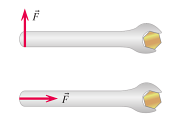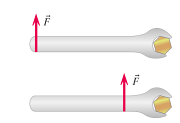Torque
Torque is the measure of who much a force acting on an object causes that object to rotate, creating a tendency for the object to rotate about an axis, fulcrum or pivot. Torque is most commonly classified as "twist", rotational force, or angular force to an object and applying it to a system changes the angular momentum of the system. The effectiveness of torque depends on where the force is applied and the position at which the force acts relative to a location.
History
The concept of torque first originated with Archimedes studies focused on levers. While he did not invent the lever, his research and work on them caused him to create the bock-and-tackle pulley systems, allowing people to use the principle of leverage to lift heavy objects. Building off of this, he explained how torque comes into play with objects that are twisting or rotating around a pivot, just as a lever does around the point of rotation. Using the Law of the Lever and geometric reasoning, Archimedes developed the concept of torque.
In 1884, the term "torque" was introduced into English scientific literature by James Thomson, a notable scientist remembered for his work on the improvement of water wheels, water pumps, and turbines. Before officially introducing the name torque, the twisting or torsional motion was referred to "moment of couple" or "angular force".
- Insert picture
Modeling and Understanding
A Mathematical Model
Torque is the cross product between the distance vector, a vector from the point of pivot (A) to the point where the force is applied, and the force vector. The force vector, [math]\displaystyle{ {\vec{F}} }[/math], is defined about a particular location.
When applying a force to an object at an angle [math]\displaystyle{ {θ} }[/math] to the radius, a different equation is required to capture both the force of the twist and the distance from the pivot point to the place where the force is applied. This equation finds the magnitude of torque exerted by a force, [math]\displaystyle{ {\vec{F}} }[/math] relative to a location (A).
For a purely perpendicular force with a force application at [math]\displaystyle{ {θ}=90{°} }[/math], [math]\displaystyle{ sin{θ}=1 }[/math] and the torque is rAF. For a force that is parallel to the lever arm at an angle [math]\displaystyle{ {θ}=0{°} }[/math], [math]\displaystyle{ sin{θ}=0 }[/math] and the torque is zero.
Units
A Computational Model
How do we visualize or predict using this topic. Consider embedding some vpython code here Teach hands-on with GlowScript
Direction of the Force
When applying a force to a system, the direction of the force greatly affects the torque and alters the effectiveness of twisting. As seen, a force parallel to the handle or object using to twist another is extremely ineffective and does not produce a torque. When the force only contains a perpendicular component, it is most effective at twisting an object.
Point of Application of the Force
The point and placement of application of the force on an object also affects who effective the torque is. The further away from the point of rotation that a force is applied, the more effective the twist is. In order to make your twisting most effective, add length to provide more leverage.
Direction of Torque
Because torque is a vector quantity, it is important to determine the direction in which torque occurs. The direction of torque is perpendicular to the radius from axis and the the force being applied to the system. The right hand rule along the axis of rotation can be used to determine the direction of torque, where torque is in the direction your thumb is pointing. Torque is in the same direction of the change in angular velocity.
Examples
Be sure to show all steps in your solution and include diagrams whenever possible
Simple
Middling
Difficult
Connectedness
- How is this topic connected to something that you are interested in?
- How is it connected to your major?
- Is there an interesting industrial application?
See also
Are there related topics or categories in this wiki resource for the curious reader to explore? How does this topic fit into that context?
Further reading
Books, Articles or other print media on this topic
External links
References
This section contains the the references you used while writing this page
http://www.mikeraugh.org/Talks/UNM-2012-LawOfTheLever.pdf http://hyperphysics.phy-astr.gsu.edu/hbase/tord.html https://www.physics.uoguelph.ca/tutorials/torque/Q.torque.intro.html

